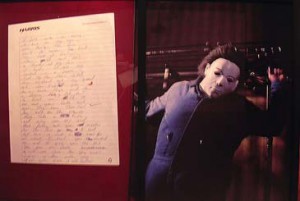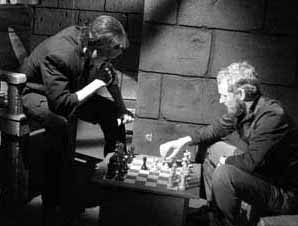
Iconic horror villain Michael Myers emotes his little heart out in Christian Jankowski’s Angels of Revenge (Photo: Paddy Johnson)
Some art just doesn’t age well. Who’s to say what lasts and what doesn’t; it’s impossible to predict cultural interest seven days from now, much less seven years, but this doesn’t mean you don’t notice when that thing you thought was totally awesome doesn’t seem all that great any more. Knowing that video artist Christian Jankowski’s new works in the exhibition Us and Them are up at The Kitchen, I’d recently been questioning whether his work suffered from this problem; after all, the artist’s proclivity for involving non-artists in his practice seemed a lot more unconventional to me previously than it does now. Was Jankowski’s Telemistica — simply featuring him asking fortune tellers questions like “What will people think of my work?” for the 1999 Venice Biennial — too easy? Could we say the same of The Holy Artwork, his 2001 performance piece made in which he played dead on the stage of televangelist Peter Spencer, who creepily preached to his congregation about how God is the bridge between art, religion and television?
The answer to these questions is an uncertain “No,” because like so much art, with age it becomes much more about the preservation of cultural concerns than it is about some joke that initially inspired the piece. But viewing Us and Them, Jankowski’s exhibition focusing on the theme of horror, made me wonder anyhow because he employs similar methods (namely collaboration) with results not nearly as interesting as they were years ago.
For example, the moderately accomplished and annoyingly punny Playing Frankenstein (2006), an eight-minute, 16 mm black-and-white silent film, pits Jankowski against a professional impersonator of “average guy Frankenstein monsters” in a game of chess. The piece is a nod to Ingmar Bergman’s The Seventh Seal, in which a knight plays chess against the Grim Reaper during the Black Plague, using the same thematics of life, death and the existence of God as Jankowski’s The Holy Artwork. But unlike The Holy Artwork, which employs the absurdity of televangelism to create bizarre discourse on art, death and religion, Playing Frankenstein adds little to this discussion. The game symbolizes the success and failures of rebirth and bodily transformation, an idea that plays out the minute you see the piece. What we are left with is a very “low-energy” match with the monster, with choice text such as “White [Jankowski] chooses unorthodox opening” and “Rook moving to H5 marks the beginning of White’s demise.” There isn’t anything that should be funny about this, and in a way it’s not, except that each time it appears it underscores the ridiculousness of scenario to begin with. The monster’s gestures are much more cavalier (and thus mildly more entertaining) than the average creature of his ilk, but with such static shots and flimsy concepts making the film feel more durational than it needs to be, the piece isn’t substantive enough to keep anything but the most dedicated viewer’s attention.

Christian Jankowski (right) plays chess with Frankenstein’s monster in — wait for it — Playing Frankenstein (Photo: Christian Jankowski)
The piece itself spun out of collaborations in Jankowski’s 23-minute long video Lacan Theorized (2006), also included in the show. If you think the title sounds pretentious, then wait until you see the film; “Otherness represents that which bourgeois ideology cannot recognize or accept,” says one actor, in between the puking of guts and various cast dismemberments. You have to acknowledge that it’s pretty amusing to watch a straight-to-DVD werewolf film deconstruct itself while gently teasing the scholars, but like Playing Frankenstein, the joke isn’t funny enough to keep a viewer engaged. Even if you read the wall text telling you the mutilated prosthetic body parts used in the film are from the theorists themselves, you’d really have to hate a scholar to sustain amusement in more than 20 minutes’ worth of his or her mutilation.
In contrast, Jankowski’s video and photography series Angels of Revenge (2006) comprises short dialogues that are for the most part fun to watch. The artist attended a horror film convention in Chicago and invited costume contest participants to write a letter to a loved one who had most betrayed them; they later read the letters to a camera in a makeshift studio set up in Jankowski’s hotel room. As a whole the work has the feel of Rejection Hotline, a collaborative piece by new media artist Jonah Peretti and his sister Chelsea inviting unlucky singles to call their service ([212] 479-7990) and “listen to a sad poem by a kindred spirit” or “cling to the unrealistic hope that a relationship is still possible.” Angels of Revenge inspires a bit darker desperation, but the fact that so many participants take the same approach to the theme waters down the implicit humor. For example, individually it’s pretty funny to see a green monster cry out “Why?? Why did it have to come to this!!!”, or some clown declaring, “When I get my revenge I will not kill you. I will tear you … from your limbs.” But it’s a little excessive to see twenty of these characters say the same thing. Horror may be about gratuitous immoderation, but this has always been what makes the genre interesting, not tedious.
Nevertheless, the acting is surprisingly good, the photographic portraits are compelling and a few of the notes that accompany each piece are quite strong. “u left with no warning. u hurt me my son [sic], our family,” writes Michael Myers, the psychotic villain of the famed Halloween movies. “The pain can’t be explain the hurt the lost of feeling. Now you will feel a touch of my pain I had.” While this letter’s extreme awfulness signals a notable exception, the fact that every participant seems to equate bad spelling with murderous behavior is just one more example of how the artist’s small successes are often stymied by work that feels overdone and stiff. And I can’t see why I should be excited about the poor penmanship of serial killers, particularly when I know that if Jankowsi had hired a fortune teller to read Myers’ future, we’d all be a lot more interested in the results.
This piece was originally published November 22nd, 2006 at The Reeler.


{ 1 comment }
I’ll never go into a kitchen again!
Comments on this entry are closed.